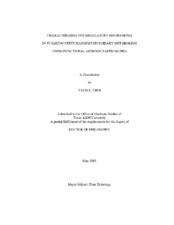| dc.description.abstract | Fusarium verticillioides is one of the most important fungal pathogens of maize and has also received increasing attention due to its ability to produce various secondary metabolites, including fumonisin B1 (FB1) and bikaverin. However, little is known about the regulatory mechanisms associated with F. verticillioides secondary metabolism. In this study, I utilized functional genomics, forward and reverse genetics, proteomics, and high efficiency homologous recombination, to better understand the complex secondary metabolism regulations in F. verticillioides. First, using the reverse genetics approach, I characterized a putative protein phosphatase gene, CPP1 as a negative regulator of FB1 biosynthesis. CPP1 gene deletion also affected multiple phenotypes such as radial growth, conidia germination rates, macroconidia formation, and hyphal swelling. Through gene complementation, I also demonstrated that the F. verticillioides CPP1 and Neurospora crassa wild-type ppe-1 gene are functionally conserved. Second, I used proteomics and quantitative real-time (qRT)-PCR, to advance our understanding of genes associated with fumonisin production. I analyzed the proteomic changes associated with the mutation in FCC1, a key positive regulator of fumonisins biosynthesis. I isolated proteins that were significantly up-regulated in either the wild-type or the fcc1 mutant, and transcriptional profiles of the genes corresponding to the selected proteins were analyzed via qRT-PCR. These genes showing expression patterns concomitant with fumonisin biosynthesis can be identified as primary targets for functional analysis. Next, I utilized REMI (Restriction Enzyme Mediated Integration) to isolate GAC1 gene, which encodes a GTPase activating protein, that serve as a negative regulator of bikaverin biosynthesis in F. verticillioides. AREA and PKS4 are downstream genes that are regulated positively and negatively by GAC1, respectively. Lastly, I generated a highly efficient homologous recombination strain of F. verticillioides. In eukaryotes, KU70 and KU80 play important roles in nonhomologous end-joining process, which leads to a high percentage of ectopic integration events during fungal transformation. By generating a KU70 gene deletion mutant (SF41), I have established a resource that will contribute to functional genomic research in F. verticillioides. | en |


